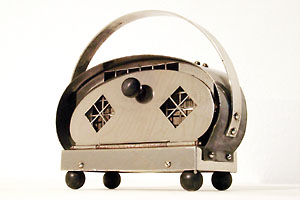Ahhh… those were the days. Or were they? Dishwasher Aids Housewife?!? We’re all glad to have dishwashers these days. In fact, until the recent economic downturn, a dishwasher was considered a necessity in most households, not a luxury. Here’s the text from this 1937 piece of appliance and societal history:
AN ELECTRIC dishwashing machine which uses six quarts of water, cleans all the dishes in the machine in eight minutes. Taking up but little room in kitchen, the mechanism is simple enough to be operated by a child. The dishes are placed in a basket which in turn is placed in the machine. The basket is self-locking, and stationary during the washing operation, thus eliminating all chance of dish breakage. An agitator with four blades revolves around the perforated basket, forcing the water upward between and over the dishes. The water strikes the dishes at all angles, doing a thorough and sanitary job.
The basic mechanics haven’t seemed to have changed much, but note that the basket is loaded and then placed in the machine. That is one heavy load. An eight minute cycle – how much pre-washing was necessary? I’m also wondering just how loud it was? Still, it was a start.



